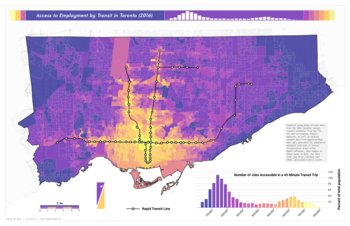
A transit desert is an area with limited transportation supply. Developed from the concept of food deserts, various methods have been proposed to measure transit deserts. Transit deserts are generally characterized by poor public transportation options and possibly poor bike, sidewalk, or road infrastructure. The lack of transportation options present in transit deserts may have negative effects of people’s health, job prospects, and economic mobility.
History
The term 'desert' has been variously applied to areas that lack key services like banks, food access, or even books. The idea of transit deserts was coined by Junfeng Jiao and Maxwell Dillivan, first appearing in print in 2013. Since that time, the concept of transit deserts has been expanded upon and competing definitions and measurement techniques have emerged.
Definitions
Gap-based measurements
Gap-based measurement techniques are the most prominent and well-defined definition of transit deserts. Such methods typically use Geographic Information Systems (GIS) based methods to measure the gap between transportation supply and demand. These methods quantify demand and supply and then subtract demand from supply in order to find the "gap" in transit service. Areas that fall below a certain threshold are termed "transit deserts". Using this method studies have found that nearly all cities in the United States have transit deserts. Studies have also consistently shown that central business districts are almost never transit deserts, but the locations of transit desert areas varies considerably in different cities.
No-transit definition
A more informal definition of transit deserts has also emerged in which areas that lack some type of transportation, most often public transportation like buses and subway stops, are termed transit deserts. Sometimes this definition has been expanded or slightly redefined to refer areas that lack a certain type of transportation such as "subway deserts".
Implications
The causes of transit deserts are much debated. Some have cited suburban sprawl and deliberately segregationist policies as some of the leading causes of transit deserts. Still others contend that transit deserts are often the result of poor planning practices and that better transit planning can help alleviate them.
Examples
Further information: List of countries by rail transport network size § Countries currently without a rail network Further information: List of countries by road network sizeSee also
General:
- Banking desert
- Book desert
- Exurb
- Food desert
- Forced rider
- Ghetto tax
- Isochrone map
- Medical desert
- Poverty map
- Redlining
- Urban resilience
- Urban prairie
Transport:
- Accessibility (transport)
- Automotive city – Urban planning prioritising automobiles
- Carfree city – Urban area absent of motor vehicles
- Freedom of movement
- Freedom Riders – American civil rights activists of the 1960s
- Montgomery bus boycott – 1950s American protest against racial segregation
- Public transport accessibility level
- Sustainable Development Goal 11 – 11th of 17 Sustainable Development Goals for sustainable cities
- Transit mall – Urban street reserved for public transit, bicycles, and pedestrians
- Transport divide – Unequal access to transport
References
- ^ Jiao, Junfeng; Dillivan, Maxwell (September 2013). "Transit Deserts: The Gap between Demand and Supply". Journal of Public Transportation. 16 (3): 23–39. doi:10.5038/2375-0901.16.3.2.
- ^ Jiao, Junfeng (12 January 2017). "Identifying transit deserts in major Texas cities where the supplies missed the demands". Journal of Transport and Land Use. 10 (1): 529. doi:10.5198/jtlu.2017.899. hdl:11299/191030. PMID 37928653.
- Bischak, Chris; Jiao, Junfeng (13 March 2018). "People are stranded in 'transit deserts' in dozens of US cities". The Conversation. Retrieved 8 July 2018.
- Jiao, Junfeng; McGrath, Nicole (26 July 2017). "Stranded in our own communities: Transit deserts make it hard for people to find jobs and stay healthy". The Conversation. The Conversation US Inc. Retrieved 8 July 2018.
- Bouchard, Mikayla (2015-05-07). "Transportation Emerges as Crucial to Escaping Poverty". The New York Times. Retrieved 8 July 2018.
- ^ Williams P., Joseph. "Stranded Without Transit". US News. U.S. News & World Report. Retrieved 8 July 2018.
- "Research Shows Transit Deserts Make it Difficult to Find Jobs, Access Medical Care | Texas Architecture | UTSOA". soa.utexas.edu. Retrieved 2018-08-13.
- Neuman, Susan B.; Moland, Naomi (5 July 2016). "Book Deserts". Urban Education. 54: 126–147. doi:10.1177/0042085916654525. ISSN 0042-0859. S2CID 147841185.
- Wallace, Lewis. "'Banking Deserts' Spread Across Low-Income Neighborhoods". NPR.org. National Public Radio. Retrieved 8 July 2018.
- Cummins, Steven; Macintyre, Sally (24 August 2002). ""Food deserts"—evidence and assumption in health policy making". BMJ: British Medical Journal. 325 (7361): 436–8. doi:10.1136/bmj.325.7361.436. ISSN 0959-8138. PMC 1123946. PMID 12193363.
- "Transit Deserts in Cook County" (PDF). The Center for Neighborhood Technology. Retrieved 8 July 2018.
- "Transit Gap Finder". AllTransit. The Center for Neighborhood Technology. Retrieved 8 July 2018.
- "Transit Desert Research - Urban Information Lab - University of Texas at Austin". www.transitdeserts.org. The Urban Information Lab.
- Goldchain, Michelle (2018-02-07). "Where D.C.'s households are most underserved by transit, mapped". Curbed DC. Vox Media. Retrieved 8 July 2018.
- Misra, Tanvi (13 July 2016). "A New Map of New York's 'Subway Deserts'". Bloomberg. The Atlantic Monthly Group. Retrieved 8 July 2018.
- Allen Jones, Diana (27 July 2017). Lost in the Transit Desert: Race, Transit Access, and Suburban Form. Routledge. ISBN 978-1-138-95424-3.
- Junfeng, Jiao. "Better planning can transform "transit deserts"". star-telegram. Fort-Worth Star Telegram. Retrieved 8 July 2018.